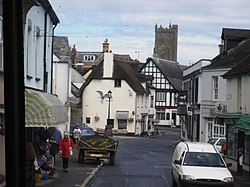Moretonhampstead
| Moretonhampstead | |
|---|---|
 Town centre |
|
| Moretonhampstead shown within Devon | |
| Population | 1,703 |
| OS grid reference | SX752860 |
| • London | 215 miles (346 km) |
| Civil parish |
|
| District | |
| Shire county | |
| Region | |
| Country | England |
| Sovereign state | United Kingdom |
| Post town | NEWTON ABBOT |
| Postcode district | TQ13 |
| Dialling code | 01647 |
| Police | Devon and Cornwall |
| Fire | Devon and Somerset |
| Ambulance | South Western |
| EU Parliament | South West England |
| UK Parliament | |
| Website | http://www.moretonhampstead.com/ |
Moretonhampstead (anciently Moreton Hampstead) is a market town,parish and former manor in Devon, situated on the north-eastern edge of Dartmoor, within the Dartmoor National Park. The parish now includes the hamlet of Doccombe, and it is surrounded clockwise from the north by the parishes of Drewsteignton, Dunsford, Bridford, Bovey Tracey, Lustleigh, North Bovey and Chagford.
At the 2011 census the population of the parish was 1,703, and Moorland electoral ward, in which Moretonhampstead lies, had a population of 2,806. The parish church is dedicated to St. Andrew. Moretonhampstead is twinned with Betton in France.
The Domesday Book of 1086 records the manor as MORTONE. This part of the name derives from the Old English for a farmstead in moorland, referring to the town's situation on the edge of Dartmoor. By 1493 "Hampstead" had been added to the name. This addition simply means "homestead", and The Oxford Names Companion (1991) speculates that this may be a family name, or a nearby place. However The Cambridge Dictionary of English Place-Names (2004) simply says the reason for the addition is unknown.
The central region of Devon was occupied by the Saxons soon after 682 AD. It was divided into vast estates, and one of these divisions included all land within the boundaries of the rivers Teign and Bovey, with Moreton as its major settlement. The present parish of over 6,000 acres (24 km2) is the residue of that ancient royal estate. It remained a royal estate immediately after the Norman Conquest of 1066, as is recorded in the Domesday Book of 1086, where it is listed as the 45th of the 72 Devonshire holdings of King William the Conqueror. The manor was held by grand serjeanty from the king by Richard de Burgh, 2nd Earl of Ulster (1259–1326) during the reign of King Edward I (1272-1307), for the annual yielding of one sparrow hawk. After that time it was the seat of Sir Philip de Courtenay (d.1314), killed at the Battle of Stirling, second son of Sir Hugh de Courtenay (died 1292) feudal baron of Okehampton, by his wife Eleanor le Despenser (died 1328), sister of Hugh le Despenser, 1st Earl of Winchester, and younger brother of Hugh de Courtenay, 1st/9th Earl of Devon (1276–1340) of Tiverton Castle. He died without progeny when Moreton Hampstead was inherited by his elder brother the 1st Earl of Devon, who gave Moreton Hampstead to his third son Robert de Courtenay, who made it his seat. Robert's grandson William de Courtenay (1377-1388) died without progeny, and eventually the manor became the property of Sir Philip Courtenay (1340–1406) of Powderham, 5th or 6th son of Hugh Courtenay, 2nd Earl of Devon (1303–1377). Thenceforth it descended with Powderham and in the time of Pole (d.1635) was a possession of Francis Courtenay (1576–1638),de jure 4th Earl of Devon.
...
Wikipedia

